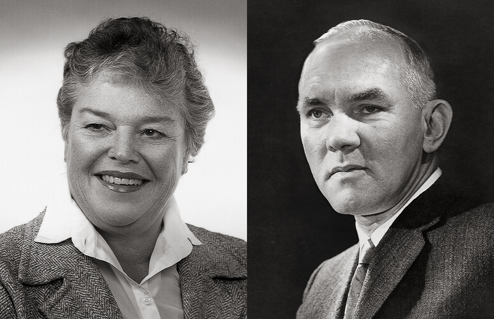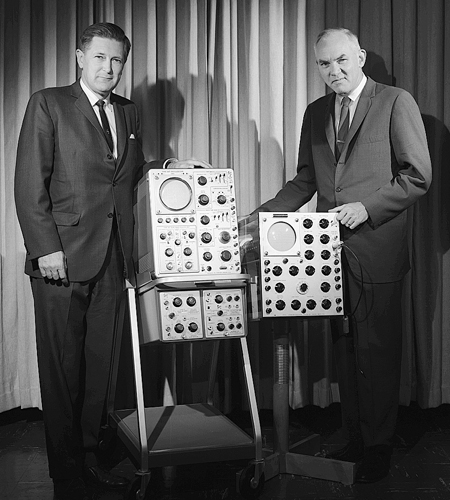The Vollum Institute Story

At one point during the construction process, Laster brought Howard Vollum to the top floor of the new institute. There were no walls yet — and as they looked out over the city of Portland, Vollum said,
“Of all the things I’ve done, this is the one that gives me the greatest gratification.”
How it all began
The Vollum Institute sits high on OHSU’s Marquam Hill campus — a distinguished collection of laboratories for basic science research and one of the country’s outstanding centers for investigating how the brain functions.

The group responsible for getting the Vollum Institute off the ground: James Castles, Howard and Jean Vollum, Sen. Mark Hatfield, Robert Frasca, Leonard Laster and Edward Herbert
By unlikely chance, the lives of these Oregonians — a medical school president, the lawyer at a successful tech company, one of that tech company’s founding engineers and his civically-engaged wife, a powerful U.S. Senator and a visionary architect — intersected in 1981 when they came together to create this new institute on a campus that had not yet become the hotbed for biomedical research that it is today.
It began with a bold idea. Drawing upon his previous experiences at the Clinical Center of the National Institutes of Health, Dr. Leonard Laster, OHSU’s second president, proposed the formation of a new center of excellence to jump-start the research program at the university. The envisioned institute would focus on “molecular medicine,” an emerging discipline that was transforming the scientific basis of patient care in the early 1980’s.
At the time funding from the Oregon State Legislature sustained only a fraction of the university’s budget and private donations were almost nonexistent. In a fortuitous turn, Laster had been invited to serve on the Board of Tektronix Inc, a Beaverton, Oregon based technology company that manufactured oscilloscopes and other electronic testing and measuring devices. Tektronix was co-founded by the brilliant engineers M.J. “Jack” Murdock and Howard Vollum. While serving on the board, Laster met and became friends with Tektronix’ legal counsel, James Castles, who had been with Howard Vollum from the very beginning. Castles sat on the board of the M. J. Murdock Charitable Trust, established after the untimely death of Murdock in 1971, and with Castles’ guidance, Laster was able to secure a small seed grant from the Trust to get the ball rolling. Howard and Jean Vollum joined the effort with a generous donation to support initial planning and development of the institute. Mark O. Hatfield, Oregon’s senior senator at the time, secured federal funds to construct a building for the new laboratory.
With generous guidance from a leader in American architecture, Pietro Belluschi, Robert Frasca of Zimmer Gunsul Frasca (ZGF) was selected to design the new institute. Frasca, who had never designed a research facility, pioneered the novel design concept of open lab space, to foster an environment of “intellectual collaborations in the service of scientific discoveries”. The Vollum Institute was the first building to reflect this architectural philosophy, and it helped put ZGF on the map.
At one point during the construction process, Laster brought Howard Vollum to the top floor of the new institute. There were no walls yet — and as they looked out over the city of Portland, Vollum said “Of all the things I’ve done, this is the one that gives me the greatest gratification.” The Vollums’ unwavering support continued after Howard’s death in 1986 when an extraordinarily generous endowment to support the new institute’s research programs was established according to the provisions of his will.
The Vollum endowment and the building might have gone to waste, but for a stroke of fate that enabled OHSU to recruit Dr. Edward Herbert from the University of Oregon to head the laboratory. An outstanding scientist and a national leader in the field of molecular neurobiology, he turned down an attractive job at Harvard to become the founding director of the institute. With Herbert's appointment, enthusiasm began to swell among faculty and OHSU advocates off campus.
Herbert recruited an impressive group of colleagues, and he went on to give the Vollum Institute its scientific theme, its standards of excellence and its direction. But tragically, he died soon after the building opened in 1987, and Oregon and the scientific world lost a remarkable leader. After that terrible moment, good fortune returned when Laster’s successor, Dr. Peter Kohler, wisely selected Dr. Richard Goodman to be the second director of the Vollum in 1990. Goodman continued to establish the institute’s early directions and expanded upon them to include studies of gene regulation, characterization neurotransmitter receptors and transporters, elucidation of second messenger systems, and determination of ion channel function.
Over the years, the Vollum spread its influence throughout OHSU by catalyzing the recruitment of many top-notch individuals to other departments. Its early success encouraged the addition of many new facilities and programs that began a transformation that persists to the present. Starting as a fragile vision, the Vollum Institute has become an impressive reality with a bright and auspicious future that continues to unfold under the current leadership and vision of its third director, Dr. Marc Freeman.
— Adapted from “How the Vollum Began” by Leonard Laster, MD, 1996–1998 Vollum Institute Biennial Report
Jean and Howard Vollum
The Vollum Institute owes its name and existence to Jean and Howard Vollum, both exceptional people and two of Oregon’s most generous philanthropists.
Genius, Quiet Leadership, Unpretentious Philanthropy

Howard Vollum was a creator and a builder, driven by his sense of curiosity. Starting with the crude cathode ray oscilloscope he refined as a junior studying physics at Reed College in 1935, Howard Vollum parlayed his many inventions, hard work and business acumen to create, together with M. J. Murdock, one of Oregon’s largest employers, Tektronix Inc.
Jean Vollum was a creator of art and a believer in building peace by bringing beauty into the lives of others. A quiet champion for culture, education and the environment, she recognized the serendipity of her good fortune in life and made every effort to expand the worlds of those who were not as fortunate.
Through their philanthropy, Howard and Jean Vollum sought to improve Oregon’s social environment. They donated tens of millions of dollars, most of it anonymously, to education, the arts, medical research, environmental preservation and social services for those in need. Major contributions went to Reed College, OHSU, the former Oregon Graduate Institute (now a part of OHSU), Mount Angel Abbey, the Oregon College of Art and Craft, the Native American Student & Community Center at Portland State University and the Ecumenical Ministries of Oregon. They established the Howard Vollum Scholarship Fund, administered by the Oregon Community Foundation, to encourage Portland-area Native Americans to pursue science, math, and engineering opportunities at the college level. Gifts from Jean Vollum led to the conservation of treasured wild areas of Oregon — Opal Creek Wilderness, Sycan Marsh Preserve and Nestucca Bay National Wildlife Refuge — and initiated the transformation of an old warehouse into the Natural Capital Center (Ecotrust building). These activities were a natural extension of her strong civic and environmental interests and vital participation in the social fabric of Portland and Oregon.
Former OHSU President Leonard Laster initially met Howard Vollum while serving on the board at Tektronix, and he and his wife, Ruth Ann, became personal friends with the Vollums. Dr. Laster reported that Howard Vollum’s interest in medical science and OHSU began in the early Tektronix days while collaborating with several neuroscientists in the medical school, helping them with their research. The company sold its first “portable” oscilloscope, the 511, to the medical school in 1947.
The Vollums decided in 1981 to contribute planning funds to OHSU — for the creation of a national institute focused on the molecular biology of the brain and nervous system. In 1986, an endowment was established for the new Institute for Advanced Biomedical Research according to the provisions of Howard Vollum’s will. Despite the Vollums’ original instructions that their contributions remain anonymous, Dr. Laster persuaded them to allow the new institute to bear their name, thus showing that OHSU was “worthy” of such private gifts and serving as a spark to encourage others to support research at the university.
Howard and Jean Vollum have left an indelible imprint on the future of the Vollum Institute and OHSU, as they have on Oregon and the country. Their quiet genius, public spirit and beneficence will long reflect on the Vollum name.
— Adapted from the 1990–1992 Vollum Institute Biennial Report
Vollum and Tek
Always the scientist-engineer, Howard Vollum was naturally drawn to the neuroscience laboratories at Oregon's medical school where his oscilloscope could be applied to research. His interest in experiments measuring bio-electric phenomena resonated with medical science and later provided philanthropic motivation.
Howard Vollum, Engineer
When Howard Vollum, as president and chief engineer, cofounded Tektronix Corporation with Jack Murdock, he never intended to build an empire. The 1945 articles of incorporation of their Portland company stated the purpose as: "to install, repair, service and sell, purchase, manufacture and otherwise acquire and deal in radio and other instruments." But it was the "other instruments" they really had in mind, specifically the cathode-ray oscilloscope.

Vollum, a brilliant if reticent young man with a physics degree from Reed College and a Legion of Merit medal for his wartime work on radar in the Signal Corps, decided that Tektronix would try to improve upon the woefully inadequate oscilloscopes of the day. Instead of the murky pictures of electronic signals provided by existing machines, he wanted to make precise measurements. As Murdock began stockpiling all the surplus electronics the company could afford, Vollum went to work in the basement of his parents' home and created a monster called the 501, weighing almost as much as its creator. Despite its size and used parts, it worked well. Its commercial successor, the 511, was launched in 1947, the first calibrated instrument that let engineers precisely measure observed electrical events.
In the new production plant, an industrial democracy that would permeate Tek culture for the next 40 years prevailed. People were called by first name. There was no clock to punch because employees kept track of their own hours. There were no privileged parking spaces. "Here, your only status is the status you earn," Vollum would say. "And when you have that, you don't need status symbols." Because Vollum knew that some of his best ideas came to him in the middle of the night, he gave all his engineers keys to the plant and bade them come and go as they pleased.
Rather than recruiting a team of Ivy League experts, Vollum hand-picked his own managers from within the company. He often ate lunch with assembly line workers and machinists in the cafeteria. He walked from bench to bench and immersed himself in the details of every project, at least once raising the wrath of board members who preferred that he spend more time at directors' meetings. Vollum's collegial management style paid off. By 1951, the company had 300 employees and sales of $4 million; by 1959, there were 3,000 employees with sales at $32 million. Tektronix had become the preeminent manufacturer of oscilloscopes and other test equipment, a leadership position that held up through the early 1970s when Howard Vollum relinquished the presidency.
—Adapted from "What's Up With Tek" by Ted Katauskas, Oregon Business, February 2000